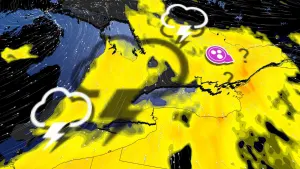
Hurricane season peaked on Sept 10, tropical activity is above-average
The peak of hurricane season in 2020 featured six systems in the Atlantic basin that were being monitored by the National Hurricane Center.
September 10 marked the peak of the Atlantic hurricane season, which is the date that historically has the highest amount of tropical activity due to optimal conditions in the Atlantic Basin.
The National Hurricane Center (NHC) says “by the beginning of September in an average year we would expect to have had four named systems, two of which would be hurricanes and one of which would be of category 3 or greater in strength.” So far 2020 has seen 17 named storms and five hurricanes.
“Sea-surface temperatures peak around September 10, which allows hurricanes to develop and become stronger. Wind shear is the change or increase of wind with height. The stronger the winds are in the upper atmosphere, the more the storm will be ripped apart,” explains The Weather Network meteorologist Matt Grinter.
“Wind shear is usually stronger in the spring and weakens during the summer, leading to little or no wind shear in the atmosphere allowing the storms to form and grow.”

Six systems are currently being monitored by the NHC. Tropical storms Rene and Paulette, located over the central Atlantic Ocean, are both expected to become hurricanes within five days. There are also two disturbances and two tropical waves being monitored in the Atlantic Ocean.
The Climate Prediction Center, part of the U.S. National Oceanic and Atmospheric Administration (NOAA) also issued a La Niña Advisory on September 10, 2020. This means that ocean surface temperatures in the central and eastern Pacific are a few degrees cooler than normal and there is a 75 per cent chance of this La Niña lasting through much of the winter in the Northern Hemisphere.
Hawaii, the Pacific coasts of Mexico and parts of the southwestern United States could see fewer hurricanes due to stronger vertical wind shear. Meanwhile, weaker vertical wind shear, trade winds and less atmospheric stability could result in more hurricanes in the Atlantic basin.

There have been so many storms this season so far that we are in danger of running out of traditional hurricane names and will soon start using the Greek alphabet.
It wouldn't be the first time: The famously active 2005 season ended up needing six names off the Greek list, with the final storm, Zeta, actually lingering into the early days of January 2006, long after the end of the "official" season on November 1st.
Thumbnail courtesy: Wikimedia Commons










